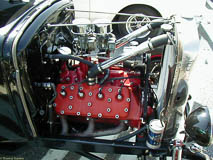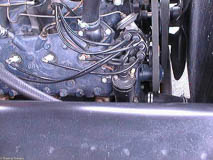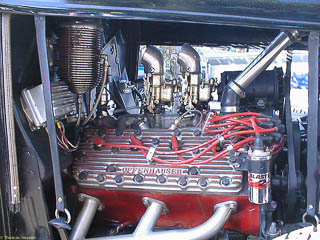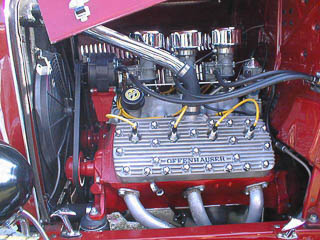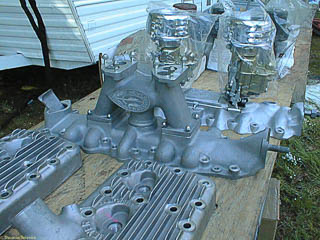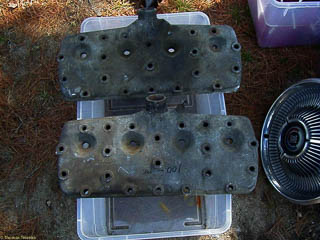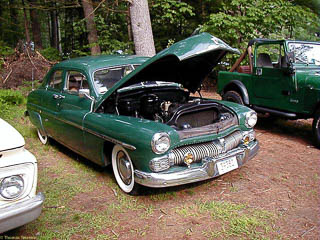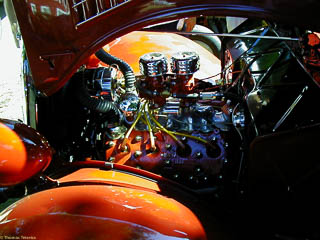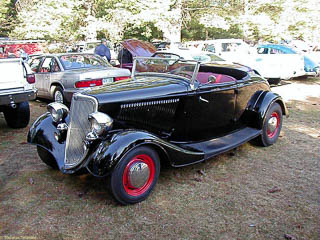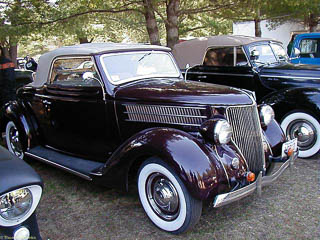Since purchasing an 1935 Ford pickup truck with a flathead engine, I've become a lot more interested in these engines. These are various pictures I've taken at car shows or swap meets.
Some good sources of information include:
- Flathead V8 History Page
- Bill Boogaart's Ford Flathead V8
- Ford V-8 Engine Workshop (includes information on flatheads and many other Ford V-8 engines)
- Roadsters page (includes a section on flatheads and lots of other stuff)
Amherst, New Hampshire
There is automobile flea market held the last Sunday of each month between April and October in Amherst, New Hampshire. There are all kinds of cars and parts there: Chevy, Mustangs, hot rods of all kinds and always a few flatheads.
Several vendors of reproduction parts show up every month including Early Ford V8 and PV Antique.
There are also usually several Flathead powered cars there, although I often forget to take a picture of the whole car and just get the engines, like here. The first engine is a new 8BA engine made from 1949 to 1953. You can identify
these because the water outlet on the head comes out by the front of the engine. The second engine is a little older, sometime between 1939 and 1948. These have 24 studs and the water outlet comes out of the middle of the cylinder
head. I've guessed that this is a 59AB block made between 1946 and 1948, but the casting numbers aren't visible here. Both these engines have been modified with high compression aluminum cylinder heads, multiple carburetor
intake manifolds, dual exhaust headers and other goodies.
This is an Eddie Meyer "sling shot" style intake manifold: the carburetor riser bolts onto the rest of the manifold. This particular one is a reproduction (by Don Orosco?) but is supposed to be from the same tooling. I don't know
if the machine work on the combustion chamber has been revised though. Speedway Motors carries the intake manifold, but only for the 1949 and later engines: both this manifold and the heads are for the 59 series engine (center
water outlets, no oil filler or road draft tube at the front of the manifold).
1936 Engine and heads
If you carefully count the studs (some are hidden by the chains), this has 21 studs in each cylinder head. There are no water pumps on this, but you can see where they would be mounted on the heads themselves, not the block. I
don't remember, but I think this was an 'LB' block meaning it had more or less modern bearings for the crankshaft that are inserted into the block. Before this, babbit bearing material was actually melted and poured into
the block and then bored to the proper clearance.
The cylinder head in the next picture is aluminum instead of cast iron on the engine. I don't know what year these heads are really, except 1936 or earlier. Most of the aluminum ones I have seen that still have visible
casting numbers seem to be from 1934.
1937 Engine and heads
This is a 1937 block that has block off plates over the water pump inlets so the block can be used with earlier 21 stud heads. Ford made these so they could replace older blocks without having to change the engine mounts or radiator
hoses (the old style water outlet/motor mounts attach at the bottom, but aren't shown in this picture). This is the only set of aluminum 1937 heads I've seen (there are occasional orphans, also, but there is no left and right
side). While they're rare, they only work with the 1937 block. In 1939, Ford went to 24 studs on the engines. The cast iron heads are don't suffer from corrosion and are more common.
1953 Mercury
I'm guessing the year, but 1953 was the last year for the Flathead in cars in the US. Trucks kept the flathead for one more year, and Canada kept them for another year. I'm sure it's a Mecury though. That would mean that this has
a 4-inch crank, and 255 cubic inch displacement. That's a newly rebuilt carburetor and it's very different from the Holley 94. I think it would be a 4 bolt Rochester 2GC. The whole engine compartment has much more in it
compared to 1932. The hood sits lower so the air cleaner is off to the side. The electric fuel pump on the inner fender doesn't look original, nor does the fuel filter, but that's still a 6 volt battery.
Even with the hood up, the engine doesn't show nearly as well as an early 30's car. Maybe that's why Mercury's like this are often destined to lose lots of that chrome, get a chopped top and end up as a lead sled.
1934 Deluxe Coupe
As far as I'm concerned, this doesn't need anything but gas and oil. All steel. The 1934 had two handles on the hood while 1933 has only one. I don't know if the bright headlight buckets are original or not, but it goes with the
deluxe model, also called '5 window' (counting the rear window), although the 3 window coupes look a little more sporty.
I suppose that after a while I might itch to put in a 59AB engine, or at least dual carburetors and maybe some reproduction Eddie Meyer heads, but I'm not the type that thrills to a chop or channel job.
1935 Deluxe Coupe
This also needs nothing but gas and oil, and the current owner has already scratched the hot rod itch. In this case those are stock truck heads (you can just make out 8RT -- car heads would be 8AB, or if you were lucky to get Mercury
or Canadian heads, 8CM). The intake looks like an Edelbrock. From the detailed picture, you can see the fuel lines come into the lid of the carburetor bowl so these are Ford/Holley 94 carburetors. The fuel pump has been blocked
off so he must be running an electric fuel pump. This leaves the firewall area very clean, but the oil filler and crankcase breather tubes are in the front alont with the radiator hoses, generator (replaced with an alternator
here), and everything else.
On the car itself, 1935 was the last year for wire wheels, and the last year for horns bolted to the fenders. The vents on the side of the hood are very different from 1934, and the grille has a V-shape, but still tall.
1934 Roadster
Moving on to body styles rather than engines, I had been confused about the difference between roadsters, cabriolets and phaetons. I basically lumped them all into the 'convertible' category. A roadster has a fold down top,
but also has no side windows, and the windshield was different, basically a frame by the cowl with hinges up near the top. A close look at the door frame shows there is no channel for side window glass.
1936 Cabriolet
You can see the windshield support for this 1936 Cabriolet is more substantial and is basically the same as for a coupe or sedan body style. You can also see the window glass. The sides of the hood for the 1936 are similar to a
1935, but the grille is more rounded. And the horns are inside the fenders, although there are still special openings in the fenders for the horns.
Phaeton
On the left is a 1935 Phaeton, and an 1936 on the right. The Phaeton's have a cloth top and a rear seat, rather like a convertible sedan instead of a convertible coupe. The windshields are essentially roadster windshields, so I
suspect that there are no side windows.

